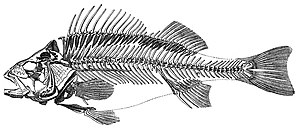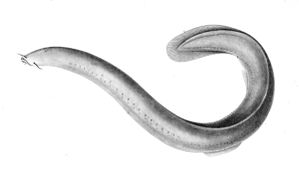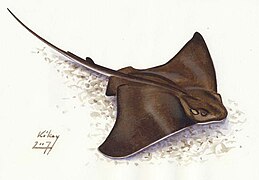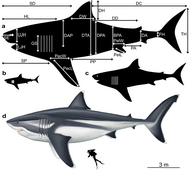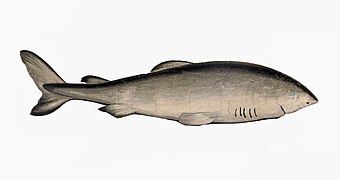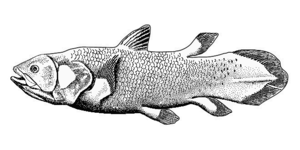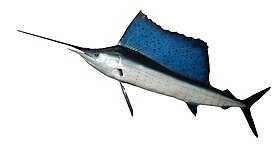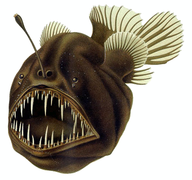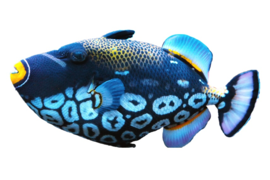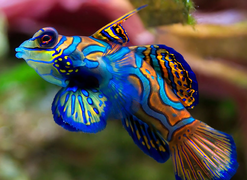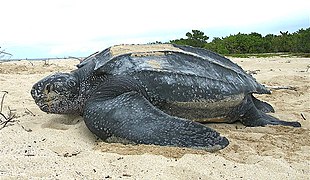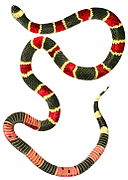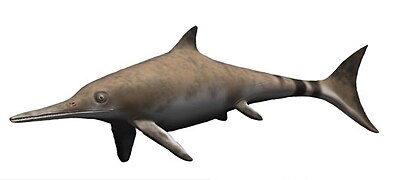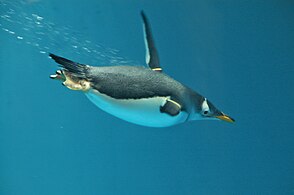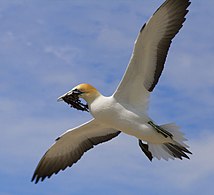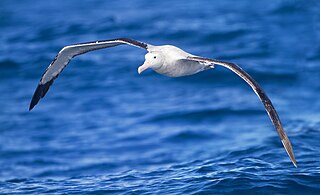
A chordate is a deuterostomic animal belonging to the phylum Chordata. All chordates possess, at some point during their larval or adult stages, five distinctive physical characteristics (synapomorphies) that distinguish them from other taxa. These five synapomorphies are a notochord, a hollow dorsal nerve cord, an endostyle or thyroid, pharyngeal slits, and a post-anal tail. The name "chordate" comes from the first of these synapomorphies, the notochord, which plays a significant role in chordate body plan structuring and movements. Chordates are also bilaterally symmetric, have a coelom, possess a closed circulatory system, and exhibit metameric segmentation.
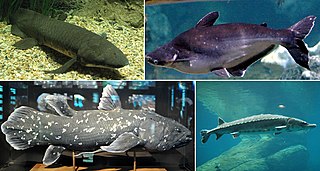
Osteichthyes, commonly referred to as the bony fish, is a diverse superclass of vertebrate animals that have skeletons primarily composed of bone tissue. They can be contrasted with the Chondrichthyes, which have skeletons primarily composed of cartilage. The vast majority of extant fish are members of Osteichthyes, which is an extremely diverse and abundant group consisting of 45 orders, over 435 families and 28,000 species. It is the largest class of vertebrates in existence today.
The Phanerozoic is the current and the latest of the four geologic eons in the Earth's geologic time scale, covering the time period from 538.8 million years ago to the present. It is the eon during which abundant animal and plant life has proliferated, diversified and colonized various niches on the Earth's surface, beginning with the Cambrian period when animals first developed hard shells that can be clearly preserved in the fossil record. The time before the Phanerozoic, collectively called the Precambrian, is now divided into the Hadean, Archaean and Proterozoic eons.
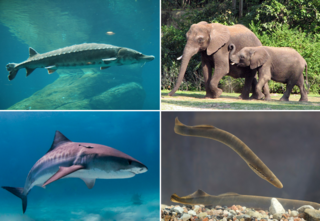
Vertebrates are deuterostomal animals with bony or cartilaginous axial endoskeleton — known as the vertebral column, spine or backbone — around and along the spinal cord, including all fish, amphibians, reptiles, birds and mammals. The vertebrates consist of all the taxa within the subphylum Vertebrata and represent the overwhelming majority of the phylum Chordata, with currently about 69,963 species described.

A tetrapod is any four-limbed vertebrate animal of the superclass Tetrapoda. Tetrapods include all extant and extinct amphibians and amniotes, with the latter in turn evolving into two major clades, the sauropsids and synapsids. Some tetrapods such as snakes, legless lizards, and caecilians had evolved to become limbless via mutations of the Hox gene, although some do still have a pair of vestigial spurs that are remnants of the hindlimbs.

Sarcopterygii — sometimes considered synonymous with Crossopterygii — is a taxon of the bony fish known as the lobe-finned fish or sarcopterygians, characterised by prominent muscular limb buds (lobes) within the fins, which are supported by articulated appendicular skeletons. This is in contrast to the other clade of bony fish, the Actinopterygii, which have only skin-covered bony spines (lepidotrichia) supporting the fins.

Vertebrate paleontology is the subfield of paleontology that seeks to discover, through the study of fossilized remains, the behavior, reproduction and appearance of extinct vertebrates. It also tries to connect, by using the evolutionary timeline, the animals of the past and their modern-day relatives.

Ichthyosauria is an order of large extinct marine reptiles sometimes referred to as "ichthyosaurs," although the term is also used for wider clades that the order resides in.

Fish anatomy is the study of the form or morphology of fish. It can be contrasted with fish physiology, which is the study of how the component parts of fish function together in the living fish. In practice, fish anatomy and fish physiology complement each other, the former dealing with the structure of a fish, its organs or component parts and how they are put together, such as might be observed on the dissecting table or under the microscope, and the latter dealing with how those components function together in living fish.

A craniate is a member of the Craniata, a proposed clade of chordate animals with a skull of hard bone or cartilage. Living representatives are the Myxini (hagfishes), Hyperoartia, and the much more numerous Gnathostomata. Formerly distinct from vertebrates by excluding hagfish, molecular and anatomical research in the 21st century has led to the reinclusion of hagfish as vertebrates, making living craniates synonymous with living vertebrates.

Euteleostomi is a successful clade that includes more than 90% of the living species of vertebrates. Both its major subgroups are successful today: Actinopterygii includes most extant bony fish species, and Sarcopterygii includes the tetrapods.

A flipper is a broad, flattened limb adapted for aquatic locomotion. It refers to the fully webbed, swimming appendages of aquatic vertebrates that are not fish.
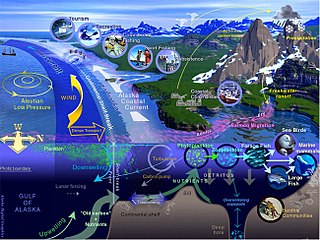
Marine life, sea life, or ocean life is the plants, animals, and other organisms that live in the salt water of seas or oceans, or the brackish water of coastal estuaries. At a fundamental level, marine life affects the nature of the planet. Marine organisms, mostly microorganisms, produce oxygen and sequester carbon. Marine life, in part, shape and protect shorelines, and some marine organisms even help create new land.
Many vertebrates are limbless, limb-reduced, or apodous, with a body plan consisting of a head and vertebral column, but no adjoining limbs such as legs or fins. Jawless fish are limbless but may have preceded the evolution of vertebrate limbs, whereas numerous reptile and amphibian lineages – and some eels and eel-like fish – independently lost their limbs. Larval amphibians, tadpoles, are also often limbless. No mammals or birds are limbless, but some feature partial limb-loss or limb reduction.

A fish is an aquatic, craniate, gill-bearing animal that lacks limbs with digits. Included in this definition are the living hagfish, lampreys, and cartilaginous and bony fish as well as various extinct related groups. Approximately 95% of living fish species are ray-finned fish, belonging to the class Actinopterygii, with around 99% of those being teleosts.

Fish are very diverse animals and can be categorised in many ways. Although most fish species have probably been discovered and described, about 250 new ones are still discovered every year. According to FishBase about 34,800 species of fish had been described as of February 2022, which is more than the combined total of all other vertebrate species: mammals, amphibians, reptiles and birds.

Fins are moving appendages protruding from the body of fish that interact with water to generate thrust and help the fish swim. Apart from the tail or caudal fin, fish fins have no direct connection with the spine and are supported only by muscles.

The evolution of fish began about 530 million years ago during the Cambrian explosion. It was during this time that the early chordates developed the skull and the vertebral column, leading to the first craniates and vertebrates. The first fish lineages belong to the Agnatha, or jawless fish. Early examples include Haikouichthys. During the late Cambrian, eel-like jawless fish called the conodonts, and small mostly armoured fish known as ostracoderms, first appeared. Most jawless fish are now extinct; but the extant lampreys may approximate ancient pre-jawed fish. Lampreys belong to the Cyclostomata, which includes the extant hagfish, and this group may have split early on from other agnathans.

Fish gills are organs that allow fish to breathe underwater. Most fish exchange gases like oxygen and carbon dioxide using gills that are protected under gill covers (operculum) on both sides of the pharynx (throat). Gills are tissues that are like short threads, protein structures called filaments. These filaments have many functions including the transfer of ions and water, as well as the exchange of oxygen, carbon dioxide, acids and ammonia. Each filament contains a capillary network that provides a large surface area for exchanging oxygen and carbon dioxide.

The evolution of tetrapods began about 400 million years ago in the Devonian Period with the earliest tetrapods evolved from lobe-finned fishes. Tetrapods are categorized as animals in the biological superclass Tetrapoda, which includes all living and extinct amphibians, reptiles, birds, and mammals. While most species today are terrestrial, little evidence supports the idea that any of the earliest tetrapods could move about on land, as their limbs could not have held their midsections off the ground and the known trackways do not indicate they dragged their bellies around. Presumably, the tracks were made by animals walking along the bottoms of shallow bodies of water. The specific aquatic ancestors of the tetrapods, and the process by which land colonization occurred, remain unclear. They are areas of active research and debate among palaeontologists at present.
